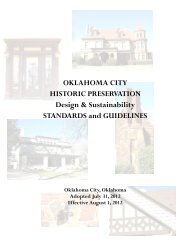OKC Plan, 2000-2020 - City of Oklahoma City
OKC Plan, 2000-2020 - City of Oklahoma City
OKC Plan, 2000-2020 - City of Oklahoma City
Create successful ePaper yourself
Turn your PDF publications into a flip-book with our unique Google optimized e-Paper software.
From an environmental perspective, <strong>Oklahoma</strong> <strong>City</strong> has several special qualities.<br />
<strong>Oklahoma</strong> <strong>City</strong> is positioned along two unique physiographic areas called the Cross Timbers and the<br />
Reddish Prairies. These features contain distinct land forms and vegetation types that mark an<br />
important biological transition between the eastern woodlands and western plains. The city also<br />
falls within the basin <strong>of</strong> three major river systems; the North Canadian, Canadian, and Cimarron.<br />
Finally, eastern <strong>Oklahoma</strong> <strong>City</strong> lies atop the Central <strong>Oklahoma</strong> Aquifer, an important and sensitive<br />
drinking water source for the metropolitan area, that contains numerous public water supply wells.<br />
The Central <strong>Oklahoma</strong> Aquifer is commonly known as the Garber-Wellington from the Garber<br />
Sandstone and Wellington rock formations.<br />
Together, these environmental resources provide substantial opportunities to enhance our<br />
quality <strong>of</strong> life while posing significant challenges to the <strong>City</strong> and development community in<br />
safeguarding their qualities.<br />
Assets and Concerns<br />
Air Quality<br />
Air pollution has been shown to be a major contributor to environmental health problems in the<br />
United States. In addition, air quality can be a major factor in limiting or promoting area economic<br />
growth.<br />
Air quality within buildings is increasingly becoming a health concern as well. Creating “tighter”<br />
buildings for energy efficiency may result in trapping irritants and allergic materials inside buildings<br />
producing what has become known as the “sick building” syndrome.<br />
The <strong>Oklahoma</strong> <strong>City</strong> metropolitan area is currently designated as “attainment” with regard to air<br />
quality by the Environmental Protection Agency. Areas can be designated as attainment or nonattainment<br />
based on National Ambient Air Quality Standards for six criterial pollutants that include<br />
carbon monoxide (CO), lead (Pb), nitrogen dioxide (NO 2 ), ozone (O 3 ), sulfur dioxide (SO 2 ), and two<br />
levels <strong>of</strong> particulate matter (PM). The benefits <strong>of</strong> “attainment” include a reduced risk for air<br />
pollution related health conditions and the designation can be used for industrial recruitment and<br />
other promotions.<br />
The Environmental Protection Agency recently implemented higher air quality standards which<br />
place the <strong>Oklahoma</strong> <strong>City</strong> metropolitan area precariously close to falling out <strong>of</strong> attainment for<br />
ozone (O 3 ). Losing attainment status would require the implementation <strong>of</strong> a mitigation plan that<br />
could include stricter vehicle inspections, fuel pump vapor recovery equipment, and the use <strong>of</strong><br />
reformulated fuels. These higher air quality standards are currently being challenged in the courts<br />
and by members <strong>of</strong> Congress.<br />
97

















